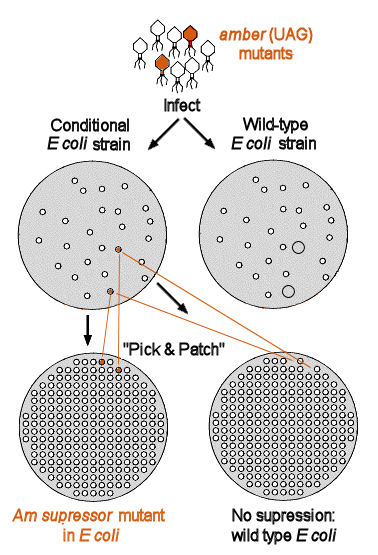 Experimental isolation &
identification of amber (UAG)
& Amber suppressor mutants
Experimental isolation &
identification of amber (UAG)
& Amber suppressor mutants
When T4 phage is added
at very low concentration to a continuous lawn of E. coli bacteria
[grey background], individual phages attack single bacteria, lyse
them, and produce more phage that go on to lyse other bacteria.
This produces a clear, circular plaque on the bacterial lawn
[white circles].
Rare mutants in a suspension of T4 phage
include an amber stop mutation (UAG) that terminates
polypeptide growth of a protein necessary for lysis of E. coli.
Addition of the suspension to a lawn of E. coli (strain CR63)
produces a number of plaques: when the plaques are replica-plated
onto a second dish with wild-type bacteria, two of the plaques do
not grow. (These regions are circled on the wild-type plate: compare
locations with the two amber colonies
on the CR63 plate). Transfer of the two plaques on the CR63
plate onto ordered "pick & patch" CR63 and
wild-type dishes again shows that they grow on the former but not
the latter. The CR63 experiment is a control,
which shows that the phage is viable. The wild-type dish shows
that the phage mutant is conditional, that is, it has
different phenotypes (growth or no growth) on different bacterial
strains.
The CR63 bacterial strain turns out to
have a serendipitously pre-existing amber suppressor
tDNA mutation. tRNA molecules produced by the
E. coli are able to "read through" the amber mutant
in the phage DNA, thus producing a functional protein and
"suppressing" the effect of the phage mutant. This
allows the mutant phage to attack and lyse the mutated bacteria,
producing the two exceptional, conditional plaques on CR63.
[Amber does not refer to the
color of the colonies. A graduate student offered to help with the
"pick and patch" experiment, on the condition that any
mutant found would be named after his mother. When the experiment
worked, the UAG phage mutant was accordingly designated "amber,"
the English word for the substance called Bernstein in
Yiddish. The Opel and Ochre stop
codons were subsequently named by analogy with Amber,
but do not refer either to colors or proper names].

